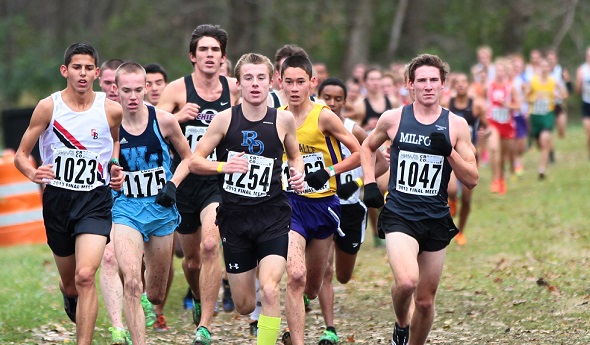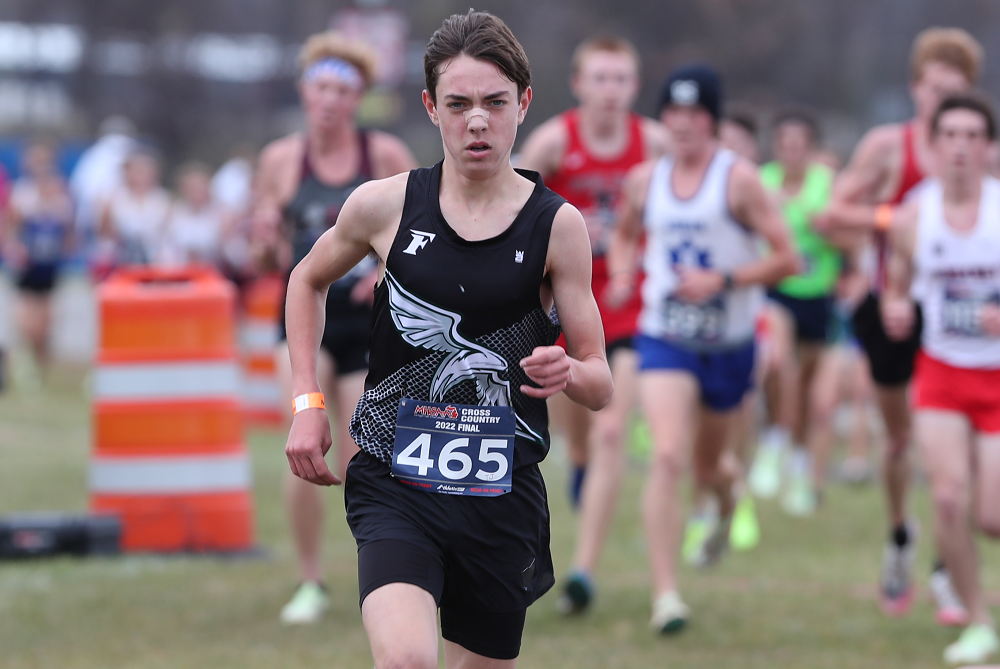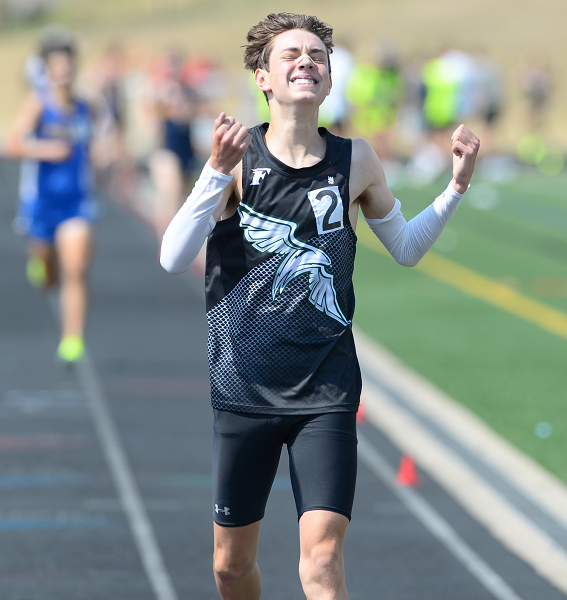
Questions Answered for D1 Winner
November 2, 2013
By Bill Khan
Special to Second Half
BROOKLYN — It's been a year of "what-ifs" for Grand Blanc junior Grant Fisher.
What if the Bobcats' soccer team hadn't made the MHSAA Division 1 Final last season?
What if Fisher, a starting midfielder as a sophomore, hadn't chosen to play in the championship game instead of running in the MHSAA Cross Country Finals, which took place on the same day?
How would he have done against the best runners in the state?
"The soccer final didn't turn out the way we wanted," Fisher said. "We lost 1-0 to East Kentwood. There's always the thought that maybe I could've come here that day and not gone to the soccer game and maybe contended for state. I don't regret that decision, but it's definitely good to be back."
There will be no questions swirling in Fisher's head for the next year. He ran to the MHSAA Lower Peninsula Division 1 championship Saturday with a time of 15:13.7, beating Kensington Lakes Activities Association West rival and defending champion Brian Kettle of Milford by 18 seconds.
The soccer issue was settled when an unbeaten Grand Blanc team was upset 1-0 in the District Final by Clarkston on Oct. 19. Fisher had already determined that he would run in the cross country finals if the Bobcats reached the soccer final.
"We definitely had a good chance to make it in soccer," Fisher said. "We were ranked fourth going in. It was really too bad of a way to go out. It's allowed me to train for cross more and focus. It's definitely helped my cross country. I haven't won a state title in cross. That's something I really wanted to do."
Fisher already had an MHSAA championship on his resume, winning the 3,200-meter run in track and field last spring after taking second in the 1,600 by the narrowest of margins. In his only cross country final before Saturday, Fisher was 44th as a freshman in 16:14.3.
He had raced Kettle one other time this season, winning by 14.6 seconds in the KLAA Lakes Conference meet on Oct. 17. As was the case in that meet, Fisher and Kettle ran together through two miles before Fisher pulled away.
"I didn't want to leave it for too late, so I made my move at two miles," Fisher said. "Brian was with me for a good amount of time. He was right on my shoulder."
Fisher became the third Bobcat to win an MHSAA championship. Mark Mesler was the Class A team champion in 1977 and Chris Catton was the 2002 Division 1 winner.
Kettle didn't come away empty-handed, as he led Milford to a third straight team championship by placing in the top two for the third year in a row.
Milford edged KLAA Lakes rival Waterford Mott, 165-170, for the title. Mott had beaten Milford in both of the teams' meetings this year, winning 88-114 at the Oakland County Championships on Oct. 5 and 63-72 in the KLAA Lakes Conference meet on Oct. 17.
Milford put it together at the right time to win a fifth championship in the last 11 years.
The difference for the Mavericks was at the No. 4 spot, where senior Kevin Black had a 24-point advantage on Mott's No. 4 runner. Three positions were relatively even between the teams, while Mott had an 18-point advantage at No. 2.
Scoring for Milford were Kettle, senior Jeffery Field (28th in the team race, 16:24.0), junior Sean Noone (31st, 16:25.2), Black (34th, 16:26.6) and senior Clinton Caddell (70th, 16:48.5).
Mott had two runners in the top 10 in the team race, third-place Ryan Robinson (15:42.6) and 10th-place Sam Albaugh (15:55.5).
Traverse City Central also was in the title hunt, taking third with 180 points. The Trojans had three runners in the top 11 in the team race, but their No. 5 runner was 118th.
PHOTO: Grand Blanc's Grant Fisher (1023), Waterford Mott's Ryan Robinson (1175), Royal Oak's Ben Hill (1254) and Milford's Brian Kettle (1047) paced the field at Saturday's LP Division 1 Final. (Click to see more from RunMichigan.com.)

Freeland's Hansen Not Focused on Joining All-Time Greats - But On His Way
By
Paul Costanzo
Special for MHSAA.com
September 29, 2023
The goal written on Matt Kaczor’s Post-It Note was sub-15 minutes, 15 seconds. That’s what the Freeland cross country coach was hoping for from star runner TJ Hansen during his junior season.
 Kaczor tore it up after seeing Hansen run a single race this fall.
Kaczor tore it up after seeing Hansen run a single race this fall.
“Knowing what he did over the summer and where he was at, seeing what his 1,600 (meter) and his mile got down to, I had a feeling he could get under 15:30 quickly,” Kaczor said. “After the first race, I looked at my assistant and was like, ‘I’ve gotta rip up that Post-It Note. I don’t think our goal is on the level of where he’s at right now.’ At first, it was break 15:15. Once I saw him race at the Under the Lights (on Aug. 18 at St. Johns), I was like, ‘Yeah, he’s going sub 15.’”
Hansen ran 15:39.6 in that first race, and on Sept. 7, in Shepherd, he ran 15:13.9 to meet the goal written on the now-shredded Post-It Note.
This past Saturday, he ran 15:03.7 at the Cadillac Veterans Serving Veterans Invitational. It’s the fastest time recorded in Michigan this year, and a signal that Kaczor might be filling out a new Post-It Note before the season is out.
“The sub-15 barrier, that’s been something on my mind for a while,” Hansen said. “Now that I’m edging closer and closer to that, it’s been exciting. With how heavy my training has been, I wouldn’t expect (to have run this fast this early). Being able to run the times I am really paints the picture for what’s ahead.”
Hansen came into the season already regarded as one of the elite distance runners in the state. He won the 3,200 meters at the MHSAA Lower Peninsula Division 2 Track & Field Finals this past spring. He’s also finished all-state (12th and fifth, respectively) the past two seasons at the LPD2 Cross Country Finals.
His current trajectory, however, would put his name near some of the state’s all-time greats. But that’s not something Hansen is focusing on.
“I really don’t like to compare myself to others,” he said. “I don’t focus on that. I try to be the best TJ Hansen that I can be. The best version of myself.”
Focusing on himself is almost necessary for Hansen, as he’s spending a lot of time during his races running by himself.
At each of the big events Freeland has run in this season, Hansen has finished at least 20 seconds ahead of his nearest competitor. That includes all divisions of the Duane Raffin Festival of Races in Holly.
In Cadillac, where Hansen ran his current best time, he was a full minute ahead of the rest of the field.
 “He’s just a special athlete,” Kaczor said. “I can’t see Freeland having someone like this in a while. He’s a generational talent. What’s crazy is, I had the school record when he was a freshman. He and Braden (Honsinger) broke it last year. But TJ has now dropped that school record (set in 1998) by almost a minute.”
“He’s just a special athlete,” Kaczor said. “I can’t see Freeland having someone like this in a while. He’s a generational talent. What’s crazy is, I had the school record when he was a freshman. He and Braden (Honsinger) broke it last year. But TJ has now dropped that school record (set in 1998) by almost a minute.”
Hansen’s achievements have already put him on a path to run at the next level, which is something of a family tradition.
His older sisters Peyton and Kiera are track & field athletes at Wayne State and Eastern Michigan, respectively. Their parents, Tim and Pam, were track & field stars at Central Michigan.
TJ has drawn the attention of coaches around the country, including from Michigan, Michigan State, Wisconsin, Tennessee and Colorado.
Having family members who know the process is a help for Hansen, and he said they’ve all been good about allowing him to choose his own path, whatever that may be.
“He’s from a good family that knows how to work and knows how to get things done,” Kaczor said. “He knows that if he puts in the work, he’s going to be at a good spot.”
While Hansen admits it can be a bit overwhelming, he’s using it as motivation to run faster and continue to put his name out there.
Also serving as motivation is 2022 Division 2 champion Connell Alford of Chelsea. Alford is among the elite group of runners in Michigan who have broken the 15-minute mark, doing it twice a year ago.
He currently has the state’s second-best time behind Hansen’s this year, running 15:09.1 at the MSU Invitational on Sept. 15.
“Whenever I see him drop a time, my main goal is to run faster,” Hansen said. “Whenever I see him run a good time, that motivates me to work hard.”
The two won’t see each other until the MHSAA Finals on Nov. 4 at Michigan International Speedway. It’s an opportunity Hansen is excited for, as it’s a chance to race and be pushed toward the lofty goals he’s set for himself. Kaczor is excited about it, too, even if it might mean having to replenish his supply of Post-Its.
“We don’t talk about winning the state title; we talk about making sure that we have great races on those days,” Kaczor said. “We can’t control how somebody else runs. It’s a matter of can we, if the weather is right and the course is in good condition, can we be one of the few guys that has run in the 14s on that course? That’s the goal. Put yourself in some great categories with those upper echelons and the greats of all-time.”
 Paul Costanzo served as a sportswriter at The Port Huron Times Herald from 2006-15, including three years as lead sportswriter, and prior to that as sports editor at the Hillsdale Daily News from 2005-06. He can be reached at [email protected] with story ideas for Genesee, Lapeer, St. Clair, Sanilac, Huron, Tuscola, Saginaw, Bay, Arenac, Midland and Gladwin counties.
Paul Costanzo served as a sportswriter at The Port Huron Times Herald from 2006-15, including three years as lead sportswriter, and prior to that as sports editor at the Hillsdale Daily News from 2005-06. He can be reached at [email protected] with story ideas for Genesee, Lapeer, St. Clair, Sanilac, Huron, Tuscola, Saginaw, Bay, Arenac, Midland and Gladwin counties.
PHOTOS (Top) Freeland's TJ Hansen leads a pack during last season's LPD2 Final at Michigan International Speedway. (Middle) Hansen enjoys a moment of exhilaration after winning the 3,200 this spring at the LPD2 Finals at Ada Forest Hills Eastern. (Top photo by Carter Sherline/Run Michigan; middle photo by Dave McCauley/Run Michigan.)

